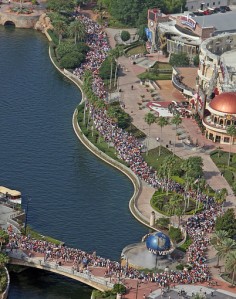Posts Tagged ‘Wizarding World of Harry Potter’
Hyperreality, the Impossibility Gap, and the Film-Theme Park Axis

Pottermanaics make Universal look like the final match of the Quidditch World Cup at the Wizarding World's opening day.
One of the only dreams I still remember years and years after I had it involved me being on a theme park ride. I was in some sort of boat floating on black water in a tunnel with a forest scene painted on the side. I don’t remember if I jumped out voluntarily or if I was somehow bumped out, but I ended up with my face pressed against this fake wall…where I saw that the forest scene was actually painted with unimaginable detail and realism. I felt like I could fall right through it. It was terrifying and exhilarating at the same time.
I’ve always been fascinated by theme parks, though I hardly think I’m unique in this respect. What I think is great about that childhood dream I had is how it reminds me of the one-paragraph short story by Jorge Luis Borges about a map so giant and real that it blended into reality. On Exactitude in Science is often mentioned as part of the definition of the concept of hyperreality, and hyperrealist philosophers have always singled out theme parks as prime examples of the idea: that in a media-soaked age like our own, the fake can seem as real, or realer, than reality.
I’ve been thinking about this (and my dream) recently because of the opening of The Wizarding World of Harry Potter at Universal Studios Islands of Adventure in Orlando. There is Ollivander’s Wand Shop. There is Hagrid’s hut. There is butterbeer (though despite rumors, there is apparently be no alcoholic variant). There are plentiful and exorbitant opportunities to purchase merchandise. On the website, Daniel Radcliffe says the Wizarding World fulfills the wish that the Harry Potter universe “could be real, and [parkgoers] could be a part of it.” Emma Watson says it’s the result of kids saying “I wish Hogwarts could be real, I want to go myself.”
Well, I do want to go myself. But does going to a chunk of Universal Orlando themed like it count? I guess it’s obvious that the answer is, marketing aside, no. But then why am I still so excited to go there?
No theme park attraction can possibly live up to the standard pitch of “stepping into the world” of a movie. But theme parks keep building them, and people (myself included) keep being, depending on how you look at it, enthralled by them, suckered by them, or both.
I’d like to believe that in the Wizarding World I could do more than ride rides, buy stuff, and look at the elaborate façade they’ve constructed. I wish I could hop a fence and discover the gritty parts of Hogsmeade that aren’t meant for tourists, instead of support buildings and a visit from security. But I’ve found that being in a place that even allows me to imagine such a thing has surprising power. That’s why when theme parks add even a drop of unexpected reality, it can be startling. Did you know, for instance, that the very Seussian palm trees at Universal’s Seuss Landing are real living plants (curved by Hurricane Andrew and then uprooted and replanted)? Or that tucked into an unassuming corner of Disney World’s Main Street USA lies an operational period-appropriate barbershop?
Theme parks are hyperrealist capitals because they promise something impossible yet deliver something that seems slightly less than impossible. That impossibility gap is everything. When we walk through the eminently fake streets of Hogsmeade at the Wizarding World, we’re in Borges’ map. We let the fake become realer than the real.
What’s interesting is how theme parks seem to know that there is no stronger medium to tie this myth into than film. This is evident nowhere more than at Walt Disney World, where the powers that be have been busy converting almost every stand-alone ride they have into something related to a film, even when it’s quite awkward. The Enchanted Tiki Room is now “run” by Iago from Aladdin and Zazu from The Lion King. The uncharacteristically terrifying Alien Encounter, which simulated a ferocious extraterrestrial spitting blood at you and breathing on the back of your neck, now uses the same mechanisms for a benign show involving Stitch. The river ride in Epcot’s Mexico, which used to be comprised simply of videos of Mexican life, now involves the Three Caballeros being animated on top of the same video in a manner not unlike a rap song that samples an older track.
Even when the film in question is one that is guaranteed to have been seen by virtually no children—such as the racist Song of the South—Disney still has enough faith in the magic of film to base a ride, in this case Splash Mountain, on (the non-racist parts of) it.
It all makes me wonder whether our love of films will one day lead to a virtual reality where we truly do not need to accept the fakeness of theme parks. An artificial world so complex and interactive that I actually could jump over my semi-proverbial Hogsmeade fence. In short, a holodeck. If you ask me, it’s going to be this, and certainly not any ridiculous fad like 3D, that will be the next revolution in cinematic entertainment.
An immersive, photorealistic world, imbued with cinematic depth, that adapts automatically to how the user interacts with it: It would stretch the impossibility gap to a breaking point and make hyperreality indistinguishable from reality in every way except for its fantasticalness. We are a long, long way from that point. But if theme parks let us feel that way for even a moment, then I’m all for them.